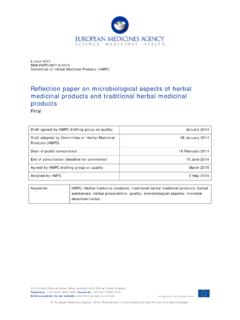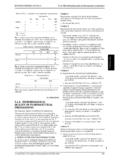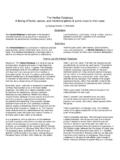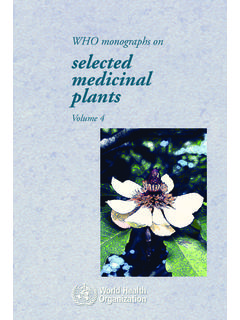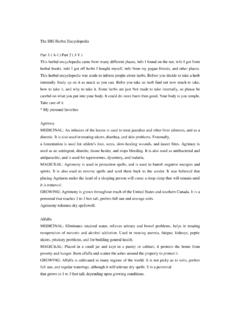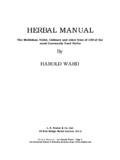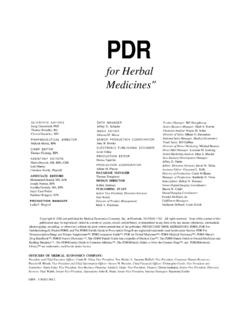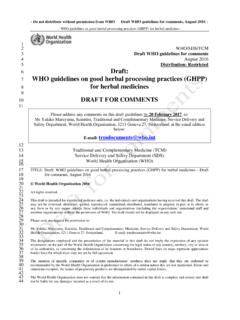Transcription of Questions & answers on quality of herbal medicinal ...
1 15 January 2015. EMA/HMPC/41500/2010 Committee on herbal medicinal Products (HMPC). Questions & answers on quality of herbal medicinal products/traditional herbal medicinal products 1. Table of content Declaration of the active substance .. 2. Specification & Testing .. 3. Specification of the finished product .. 3. Testing .. 4. 7. Mycotoxins .. 8. Microbiological quality .. 9. Fumigants .. 11. Manufacturing .. 12. quality of water .. 13. Stability .. 13. Essential oils as active substances .. 18. 1. Throughout the document and unless otherwise specified, the term ' herbal medicinal product ' includes 'traditional herbal medicinal product '. 30 Churchill Place Canary Wharf London E14 5EU United Kingdom Telephone +44 (0)20 3660 6000 Facsimile +44 (0)20 3660 5520. Send a question via our website An agency of the European Union European Medicines Agency, 2015.
2 Reproduction is authorised provided the source is acknowledged. Declaration of the active substance (1) Question How should the drug extract ratio and the extraction solvent be declared for extracts prepared from fresh herbal substances?'. Answer The genuine drug extract ratio (DERgenuine) and the extraction solvent should be declared for extracts. The DERgenuine is the ratio of the quantity of the herbal substance to the quantity of the resulting native (genuine) extract. No matter whether the extract is prepared from a dry or a fresh herbal substance, the quantity of the herbal substance should simply be the quantity used, including any water naturally contained in the herbal substance. The quantity of the native extract should be set as the quantity obtained after the extraction process, including any water and other solvent present in the extract, but without the quantity of any excipient added after the extraction process (excipients used for standardisation or technological reasons).
3 Due to the natural variability of the herbal substance, the DERgenuine will normally be a range, :1. In the case of tinctures, where all of the extraction solvent is maintained in the final extract, the DERgenuine will equal the drug extract ratio. Likewise, the declaration of the extraction solvent should be based on the concentration of the solvent used, without taking any water naturally contained in the herbal substance into account. Example: An extraction solvent prepared as a mixture of 5,000 kg ethanol 94% m/m plus 1,000 kg purified water means that the declared solvent should be ethanol 78% m/m. For further guidance, see Guideline on declaration of herbal substances and herbal preparations in herbal medicinal products/traditional herbal medicinal products (EMA/HMPC/CHMP/287539/2005 Rev.)
4 1). Questions & answers on quality of herbal medicinal products/traditional herbal medicinal products EMA/HMPC/41500/2010 Page 2/19. Specification & Testing Specification of the finished product (1) Question Which limits are acceptable for the content of active substances with constituents of known therapeutic activity in the finished product at the time of manufacture and at the end of shelf-life? Answer In the guideline on quality of herbal medicinal products (CPMP/QWP/2819/00 Rev. 1) it is stated that for herbal medicinal products with constituents of known therapeutic activity, the variation at the end of shelf-life should not exceed 5% of the declared assay value. Furthermore, according to paragraph of the guideline on specifications: test procedures and acceptance criteria for herbal substances, herbal preparations and herbal medicinal products (CPMP/QWP/2820/00 Rev.
5 1) only in exceptional cases different acceptance criteria for release versus shelf-life specifications apply. Because the European Pharmacopoeia (Ph. Eur.) allows standardisation for herbal preparations with constituents of known therapeutic activity, the HMPC is of the opinion 5% of the declared assay also applies at release. However, the guideline on specifications: test procedures and acceptance criteria for herbal preparations and herbal medicinal products/traditional herbal medicinal products also states that The concept of different acceptance criteria for release versus shelf-life specifications applies to herbal medicinal products. This concept can also apply in exceptional cases to herbal substances and herbal preparations, if justified. Examples where this may be applicable include assay and impurity (degradation product ) levels.
6 Therefore, if justified and authorised, broader limits may be acceptable. Nevertheless, no general limits can be recommended because the variation depends on the herbal substance used. Setting the limits is a case by case decision. Hence in case of herbal medicinal products with constituents of known therapeutic activity, applicants are advised to ask the regulatory authorities which data are required to justify limits above 5% of the declared assay value. Questions & answers on quality of herbal medicinal products/traditional herbal medicinal products EMA/HMPC/41500/2010 Page 3/19. Testing (1) Question What guidance is available on how to take and handle representative samples for analysis?'. Answer Reference is made to Ph. Eur. on herbal drugs: sampling and sample preparation.
7 (01/2008:20820). (2) Question Is a joint assay of the active substances in a combination product acceptable?'. Answer Yes, a joint assay would be acceptable if satisfactorily justified in line with the herbal quality guidelines (EMEA/HMPC/CHMP/CVMP/214869/06, CPMP/QWP/2820/00 Rev 1, CPMP/QWP/2819/00 Rev 1). Example: The group determination of flavonoids from birch leaves and java tea leaves. In addition, the identity of the individual active substances should be shown by chromatographic procedures ( TLC). (3) Question A mixed extract is produced by simultaneous extraction of several herbal substances with the same extraction solvent. Is it acceptable to perform an analysis using only one representative analytical marker for stability testing of the HMP? Answer In principle mixed extracts should fulfil the same requirements as mixtures of single extracts and the individual extracts within the mixture should be quantified.
8 Mixed extracts are produced in a special manufacturing process as an unique extract, but these extracts contain the specific extracts from the different individual herbal substances. The analytical methods should be selected as prescribed in the Guideline on quality of combination herbal medicinal products/traditional herbal medicinal products (EMEA/HMPC/CHMP/CVMP/214869/2006). (4) Question For the active substance, is it possible to substitute the marker described in the European Pharmacopoeia by an alternative marker?'. Answer It is possible. The use of the alternative marker should be justified on the basis of sufficient data. Pre- clinical and clinical data should be considered in the justification. Questions & answers on quality of herbal medicinal products/traditional herbal medicinal products EMA/HMPC/41500/2010 Page 4/19.
9 (5) Question Can different analytical markers be used for release and stability testing?'. Answer In principle, the manufacturer should use the same marker for release and stability testing. In exceptional cases different markers can be accepted where justified on the basis of analytical data. (6) Question In practice it is sometimes difficult to find suitable analytical markers for quantitative purposes. Can primary metabolites of herbal drugs also be used as analytical markers for stability testing in case suitable secondary metabolites are not available? Is this also possible for release testing?'. Answer The EMA Reflection paper on markers used for quantitative and qualitative analysis of herbal medicinal products and traditional herbal medicinal products (EMA/HMPC/253629/2007) gives an overview on possibilities and problems with markers.
10 Markers (analytical markers) should ideally be characteristic or specific for the plant/ herbal preparation and also stability-indicating at the same time. However, this may not always be fulfilled. Where a marker is unstable in normal conditions of use ( poor analytical tool ), it may not be suitable for determination of an appropriate shelf-life. In some cases, due to low concentrations present or where a chromophore is lacking, potential marker substances may not be readily detectable by the usual chromatographic methods. In many cases marker substances occur in groups of structurally related constituents and a selective separation is difficult ( tannins, proanthocyanidins, saponins etc.). It is generally assumed that markers should belong to the group of secondary plant metabolites such as flavonoids, saponins, terpenes, phenols etc.










